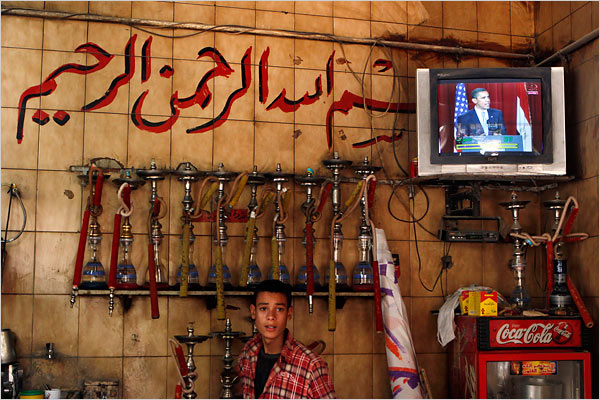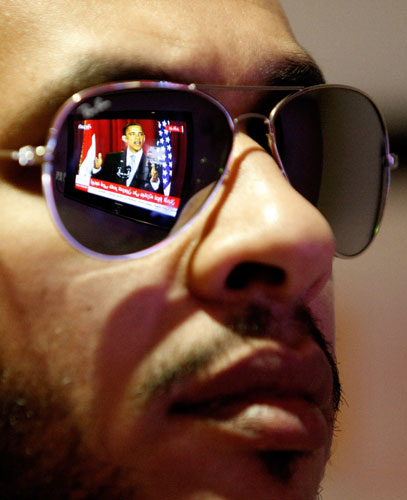The coverage of Obama’s speech in Cairo continued this weekend with a slide show at the New York Times. The slides essentially were all the same, with each showing Obama’s televised image in one locale or another. The set of slides included photographs from India, Africa, and LA, but the majority were from the Middle East. The point, I assume, was to represent both a global audience and the likelihood of varied responses in diverse settings. Too many of them, however, might as well have been Orientalist illustrations.

This photo from Cairo was the first in the set and thus capable of setting the frame. Obama is on the TV placed above a Coke machine–the only two electrical machines evident without close study of the photo–while the scene is dominated by the hookahs and Arabic script on the worn wall. The US is aligned with modern technology, all the better for global distribution of our products and ideas, while those watching in the Middle East are still living in a bygone world of mysterious inscriptions and exotic customs.
The young man in the center of the frame is a particularly nice touch. Lithe boys were one element of Orientalist iconography, although this kid is fully clothed for the contemporary US audience. Indeed, he might pass for a young Obama. Thus, he is the central object of struggle in the drama being constructed. Will he be influenced by the parochial Arab culture that surrounds him, or by the American president? Will the TV and Coke machine, which are on the border of this scene, be able to break the spell of the culture represented by the drug paraphernalia surrounding him? Obviously, we are to hope that he will grow up to become a good citizen like his newly available role model, Barack Obama. The fact that he will grow up in a dictatorship propped up by billions of dollars in US aid is not mentioned.
Were a Black Panther around, it might be mentioned. The image of that kind of African-American community organizer has been conspicuously absent from the Obama haigiography, but the following image can bring the Panthers to mind.

This photo was not part of the Times slide show, perhaps because it complicates both sides of the rhetorical transaction. Now Obama is projected onto the sunglasses of what could be a stony auditor, someone quite different from the supposedly impressionable young man shown above. And Obama becomes a small yet garish image of himself, someone distant from the kind of politics represented by black men wearing dark glasses and hard faces. Perhaps the image still contains a fantasy of media influence, as if the TV image were being projected from the screen through the glasses directly into the eye and brain. (Note how equipment figures significantly in each photograph.) But we see instead how an image can be reflected back toward the sender. Instead of persuasion, we are shown resistance.
The second photo is from Riyadh, and so we should note that he probably is not black and if there is resistance it could be on behalf of privilege and dogmatism. Both images are studies in some of the problems of persuasion, however, and they provide a basis for thinking about how to think about global audiences. The first photograph presents an all too comfortable conception of the Middle East; the second suggests a critical counterpoint. Each is but one account, and far too many others remain ignored.
Amr Nabil/Associated Press and Hassan Ammar/Associated Press.
“we should note that he probably is not black”
Please tell me what constitutes “black?” In my opinion, the designation is a complex sociological label implying (among other things) being of African descent, being of a lower status, unknowable, undesirable, frightening, criminal, inferior, urban, ghettoized. Note that the word has been used by Europeans for centuries to marginalize the indigenous populations in “the colonies,” whether in India, Africa, South America, Australia or the Middle East.
So, what is “black” and what difference does this label make to the strong message of the image? I believe it is irrelevant. The cheese stands alone.
I knew that line would be likely to get me in trouble, but the hour was late and I had to finish the post. I put it in because the Black Panther analogy created an assumption about the individual in the photo that could be considered inaccurate, misleading, or offensive by both both Arabs and African-Americans. And Arab could say, “don’t use that colonial label on me,” while an African-American could say, “don’t mistake my history of suffering with the Saudi’s life of privilege.” “Black” is a very tricky sociological label indeed. The photo works because it depicts resistance through an image that can evoke both the colonial experience and America’s tragic history. To understand the image, one needs to work with and work through available labels. That, too, is tricky, and not because the labels are irrelevant.
@Hariman: There is a point which I must clarify. I did not say “labels are irrelevant” in any context. I said the label was irrelevant to this *particular* image. My reaction to it was based solely on the impact of the small, intensely colored screen reflected in the sunglasses which hide the eyes of the viewer. For me, the viewer was secondary and only identified in my mind as a youngish male.
Although I did not comment on it, I saw no real reason to include Black Panther references. If your aim was to evoke resistance movements, any number of them could have been equally appropriate and there would have been no need to disambiguate with regard to ethnic descent.